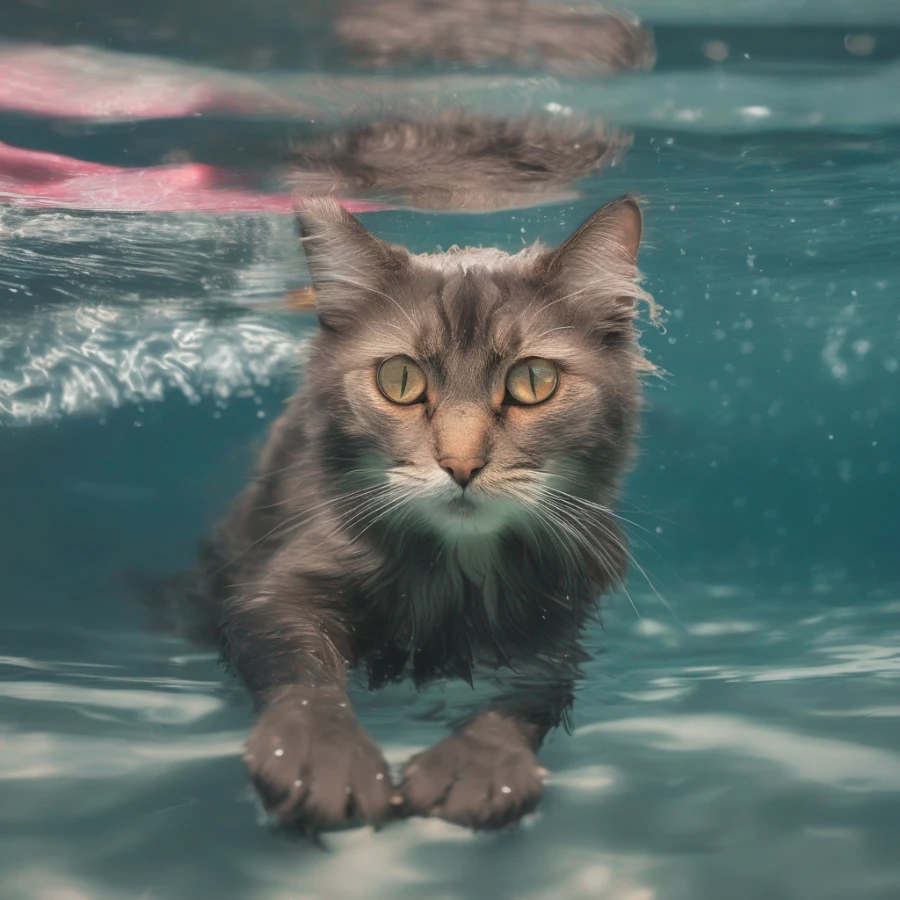Arthritis in Cats: Diagnosis, Causes, Symptoms & Treatment
Arthritis in cats is a condition where the joints become inflamed and degenerate, leading to pain, stiffness, and reduced mobility. It commonly affects older cats and can impact their quality of life.

What is an Arthritis
Arthritis in cats is a chronic condition characterized by inflammation and degeneration of the joints. It commonly affects older cats, although it can occur in cats of any age. The joints most commonly affected by arthritis in cats include the hips, elbows, knees, and spine.
The primary cause of arthritis in cats is wear and tear on the joints over time, leading to the breakdown of cartilage and the development of bony spurs. This can result in pain, stiffness, and reduced mobility. In some cases, arthritis may also be secondary to other conditions such as joint infections, trauma, or autoimmune disorders.
The symptoms of arthritis in cats can vary, but common signs include reluctance to jump or climb, difficulty using the litter box, changes in grooming habits, decreased activity levels, limping or favoring certain limbs, and behavioral changes. Cats with arthritis may also exhibit decreased appetite and weight loss due to the discomfort associated with movement.
Diagnosing arthritis in cats typically involves a combination of physical examination, evaluation of medical history, and diagnostic imaging such as X-rays. Blood tests may also be conducted to rule out underlying causes or assess overall health.
While there is no cure for arthritis in cats, there are various treatment options available to manage the condition and alleviate symptoms. These may include pain medications, joint supplements, weight management, physical therapy, and environmental modifications to improve mobility and comfort. In severe cases, surgery may be recommended.
Prevention of arthritis in cats focuses on maintaining a healthy weight, providing a balanced diet, promoting exercise, and minimizing the risk of injuries. Regular veterinary check-ups can help identify and manage arthritis at an early stage.
Overall, with proper management and care, cats with arthritis can lead comfortable and fulfilling lives. It is important to work closely with a veterinarian to develop an individualized treatment plan that addresses the specific needs of the affected cat.
Cat Arthritis Symptoms
The symptoms of arthritis in cats can vary, but common signs to look out for include:
Reluctance to jump or climb: Cats with arthritis may avoid activities that require them to exert pressure on their joints, such as jumping onto high surfaces or climbing stairs.
Difficulty using the litter box: Arthritic cats may find it challenging to squat and position themselves properly in the litter box, leading to accidents outside the box.
Changes in grooming habits: Cats with arthritis may have difficulty reaching certain areas of their body, resulting in decreased grooming and a scruffy or unkempt appearance.
Decreased activity levels: Arthritic cats may become less active and spend more time sleeping or resting. They may avoid playful activities they once enjoyed.
Limping or favoring certain limbs: Cats with arthritis may exhibit lameness or a noticeable limp, especially after periods of rest. They may also favor one limb over the other when walking or running.
Stiffness and decreased mobility: Arthritic cats may have difficulty moving smoothly and may appear stiff or slow when walking. They may also have trouble getting up from a lying position.
Behavioral changes: Cats in pain from arthritis may exhibit changes in behavior, such as increased irritability, aggression, or withdrawal from social interaction.
Decreased appetite and weight loss: Arthritic cats may experience discomfort or pain while eating, leading to reduced appetite and weight loss.
It's important to note that these symptoms can also be indicative of other health conditions, so it's essential to consult a veterinarian for a proper diagnosis if you suspect your cat may have arthritis.
Causes of Arthritis in Cats: Understanding the Triggers of Feline Health Issues
The exact causes of arthritis in cats can vary, but some common factors that can contribute to the development of arthritis include:
Age: Arthritis is more commonly seen in older cats. As cats age, the wear and tear on their joints can lead to the development of arthritis.
Joint injury or trauma: Previous injuries, such as fractures or dislocations, can increase the risk of arthritis in cats. Trauma to the joints can cause damage to the cartilage, leading to joint deterioration over time.
Genetic predisposition: Some cat breeds may have a higher genetic predisposition to developing arthritis. For example, breeds such as Maine Coons and Persians may be more prone to joint problems.
Obesity: Excess weight puts additional strain on the joints, increasing the risk of arthritis development. Overweight or obese cats are more susceptible to joint problems.
Joint abnormalities or deformities: Cats born with or developing joint abnormalities or deformities, such as hip dysplasia or patellar luxation, are more likely to develop arthritis.
Inflammatory joint diseases: Certain inflammatory joint conditions, such as immune-mediated arthritis or septic arthritis (caused by a joint infection), can lead to chronic inflammation and subsequent arthritis.
Infectious diseases: Some infectious diseases, like feline leukemia virus (FeLV) or feline immunodeficiency virus (FIV), can weaken the immune system and increase the risk of joint inflammation and arthritis.
It's important to note that while these factors can contribute to the development of arthritis in cats, not all cats with these risk factors will necessarily develop the condition. The specific cause of arthritis in an individual cat may be multifactorial, and it's best to consult with a veterinarian for an accurate diagnosis and appropriate management.
Diagnosis of Arthritis in Cats: Identifying Feline Health Conditions
The diagnosis of arthritis in cats typically involves a combination of clinical signs, physical examination findings, and diagnostic tests. Here are some common methods used for diagnosing arthritis in cats:
Physical examination: A veterinarian will perform a thorough physical examination of the cat, assessing their gait, joint mobility, and signs of pain or discomfort. They may also palpate the joints to check for swelling or tenderness.
Medical history: The veterinarian will inquire about the cat's medical history, including any previous injuries, known joint conditions, or chronic illnesses that could contribute to arthritis.
Imaging tests: X-rays (radiographs) are commonly used to evaluate the joints and assess for signs of arthritis, such as joint space narrowing, bone spurs, or changes in bone density. In some cases, other imaging techniques like ultrasound or magnetic resonance imaging (MRI) may be recommended for a more detailed evaluation.
Joint fluid analysis: In cases where there is joint swelling or suspicion of an underlying joint infection, a sample of joint fluid may be collected through a procedure called joint aspiration. The fluid is analyzed for signs of inflammation, infection, or abnormal cell counts.
Blood tests: Blood tests may be conducted to rule out other potential causes of joint inflammation or to assess overall health. These tests can include a complete blood count (CBC), biochemical profile, and tests for infectious diseases if indicated.
It's important to note that diagnosing arthritis in cats can sometimes be challenging due to their stoic nature and the subtle nature of early signs. The veterinarian will use a combination of clinical judgment, physical examination findings, and diagnostic tests to reach a diagnosis.
Treatment of Arthritis in Cats: Managing Feline Health Conditions
The treatment of arthritis in cats focuses on managing pain, reducing inflammation, and improving joint function. Here are some common treatment options for arthritis in cats:
Medications: Non-steroidal anti-inflammatory drugs (NSAIDs) are often prescribed to alleviate pain and reduce inflammation in arthritic joints. However, it's important to note that not all NSAIDs are safe for cats, and they should only be used under veterinary supervision. Other medications such as corticosteroids or joint supplements may also be recommended.
Weight management: Maintaining a healthy weight is crucial for reducing the burden on arthritic joints. Cats with arthritis should be fed a balanced and appropriate diet to prevent obesity and promote overall joint health.
Physical therapy: Physical therapy techniques such as gentle exercise, stretching, and massage can help improve joint mobility, reduce stiffness, and strengthen surrounding muscles. These therapies should be performed under the guidance of a veterinarian or a certified animal rehabilitation therapist.
Environmental modifications: Making changes to the cat's environment can help minimize the impact of arthritis. Providing soft and padded bedding, ramps or stairs to access elevated surfaces, and litter boxes with low sides can make it easier for arthritic cats to move around without straining their joints.
Dietary supplements: Certain dietary supplements, such as omega-3 fatty acids and glucosamine, may have anti-inflammatory and joint-protective properties. These supplements can be recommended by a veterinarian and are often used in conjunction with other treatment approaches.
Pain management: Additional pain management techniques, such as acupuncture or laser therapy, may be beneficial in some cases. These methods can help reduce pain and promote healing in arthritic joints.
It's important to consult with a veterinarian for an accurate diagnosis and to determine the most appropriate treatment plan for an arthritic cat. Treatment options may vary depending on the severity of the arthritis, the cat's overall health, and individual needs. Regular veterinary check-ups are also important to monitor the cat's progress and make any necessary adjustments to the treatment plan.
Prevention of Arthritis in Cats: Promoting Feline Health and Well-being
Maintain a healthy weight: Obesity can put extra strain on the joints and contribute to the development of arthritis. Ensure that your cat maintains a healthy weight through a balanced diet and regular exercise.
Provide a comfortable environment: Create an environment that promotes joint health by providing soft and padded bedding for your cat. Avoid hard surfaces that can exacerbate joint pain.
Regular exercise: Encourage gentle exercise and play to keep your cat's joints mobile and muscles strong. Interactive toys and climbing structures can help keep them active.
Joint supplements: Discuss with your veterinarian the use of joint supplements, such as glucosamine and omega-3 fatty acids, which can help support joint health and reduce inflammation.
Regular veterinary check-ups: Routine veterinary visits are essential to monitor your cat's overall health, including joint health. Early detection of arthritis can lead to prompt intervention and better management.
Consider age and breed: Some cat breeds, such as Maine Coons and Persians, may be more prone to developing arthritis. Additionally, older cats are more susceptible to joint issues. Be aware of these factors and provide appropriate care and monitoring.
Environmental modifications: Make adjustments to your cat's environment as they age to accommodate any mobility limitations. This may include providing ramps or stairs to access elevated surfaces and litter boxes with low sides.
Remember, prevention strategies may not eliminate the possibility of arthritis in cats, especially in cases where it is caused by genetic or developmental factors. However, by implementing these measures, you can help reduce the risk and improve your cat's overall joint health.



